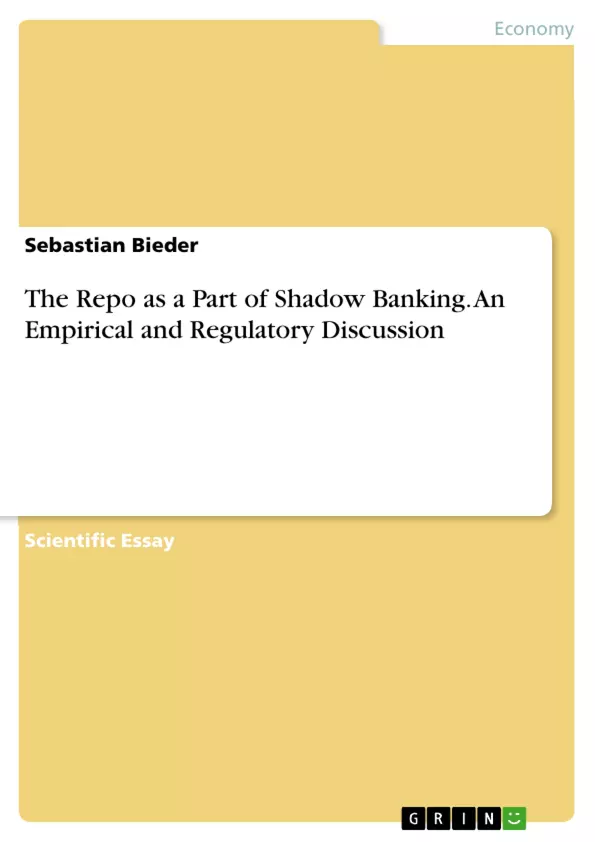Repos are not only one of the financial instruments with crucial importance for funding. They primarily played a significant role to the recent financial crisis as well. Hence, the question is, whether Basel III and the Dodd-Frank Act successfully mitigate instabilities in repo markets.
Within this analysis and by reviewing key studies, I am going to explain two statements: Firstly, how Gorton and Metrick (2012) empirically verified that the repo functioned as a crisis trigger, and secondly, how Valderrama (2010) modeled an economic framework to deduce several constrictions for regulators. These researches build the base for the evaluation of repo regulations. I explain why capital requirements and CCPs are the most effective preventive policies to reduce both counterparty credit risk and systemic liquidity risk associated with repos. Under a libertarian evaluation approach, specifically the CCP framework constitutes an effective element and starting point for regulatory haircuts and liquidity ratios.
Inhaltsverzeichnis (Table of Contents)
- INTRODUCTION
- SECURITIZED BANKING
- The repurchase agreement
- Characteristics
- Market and volumes
- The repo's transformation
- In the pre-crisis period
- Short-term funding and shadow banking risks
- During times of instabilities and distress
- The contribution of shadow banking and repos to the crisis
- Repo risks as a cause of instabilities
- STUDIES ON REPO RISKS
- Counterparty risk and the run on repos
- ABX indices and the LIB-OIS spread
- Data and empirical tests
- Discussion
- Margin calls and bankruptcies in the repo market
- The model
- Model results
- Discussion
- REGULATIONS
- Basel III
- Prevention of a run on repo
- Reduction of liquidity risks
- The Dodd-Frank Act
- Prevention of a run on repo
- Reduction of liquidity risks
- Discussion and outlook
- Summarizing evaluation
- Political recommendation
- The future of repos
Zielsetzung und Themenschwerpunkte (Objectives and Key Themes)
The main objective of this paper is to analyze the effects of Basel III and the Dodd-Frank Act regulation on the negative externalities connected to repo transactions, specifically focusing on mitigating negative externalities. It aims to assess whether and under what conditions these regulatory policies effectively reduce risks associated with repo markets, such as counterparty credit risk and liquidity risk. The paper seeks to understand the impact of regulation on repo market stability and prevent future financial crises.
- The role of repos in the financial crisis, particularly as a potential trigger and a contributor to systemic liquidity risks
- The effectiveness of Basel III and the Dodd-Frank Act in mitigating risks associated with repos, such as counterparty credit risk and liquidity risk
- The importance of regulatory measures like capital requirements and central counterparties (CCPs) in reducing systemic risk within the repo market
- The need to differentiate between causal factors and symptomatic developments in regulating financial instabilities
- The significance of understanding the impact of regulations on the balance sheets and risk exposures of financial institutions
Zusammenfassung der Kapitel (Chapter Summaries)
- Introduction: The chapter introduces the concept of repurchase agreements (repos) and their significance as a financial instrument, highlighting their central role in short-term funding and derivatives markets. It outlines the link between repos, shadow banking, and the financial crisis, particularly emphasizing the run on repo markets and systemic liquidity shocks as key contributing factors.
- Securitized Banking: This chapter delves into the characteristics of repos, their market dynamics, and their transformation over time. It examines the evolution of repo markets, particularly in the pre-crisis period, and explores their role in facilitating short-term funding and shadow banking activities. The chapter also discusses the risks associated with repos, including counterparty credit risk and liquidity risk, and their potential contribution to the financial crisis.
- Studies on Repo Risks: This chapter examines empirical and theoretical studies related to repo risks. It explores the findings of Gorton and Metrick (2012) on the role of repos in triggering the financial crisis through counterparty risk and the run on repo markets. The chapter also presents Valderrama's (2010) model, which explores the systemic liquidity risks associated with repos and their impact on market stability.
- Regulations: This chapter analyzes the regulatory responses to repo market risks, focusing on Basel III and the Dodd-Frank Act. It evaluates the effectiveness of these regulations in mitigating counterparty credit risk, liquidity risk, and systemic risk associated with repos. The chapter highlights the importance of capital requirements and CCPs as key regulatory measures in managing these risks.
Schlüsselwörter (Keywords)
This paper explores the critical role of repurchase agreements (repos) in financial markets, particularly within the context of shadow banking. It examines the systemic risks associated with repos, including counterparty credit risk and liquidity risk, and their potential impact on financial stability. The paper focuses on the effectiveness of regulations like Basel III and the Dodd-Frank Act in mitigating these risks and promoting a more resilient financial system. Key terms include: repo market, shadow banking, financial crisis, systemic risk, counterparty credit risk, liquidity risk, Basel III, Dodd-Frank Act, capital requirements, central counterparties (CCPs), regulatory oversight.
- Arbeit zitieren
- Sebastian Bieder (Autor:in), 2014, The Repo as a Part of Shadow Banking. An Empirical and Regulatory Discussion, München, GRIN Verlag, https://www.grin.com/document/301171



